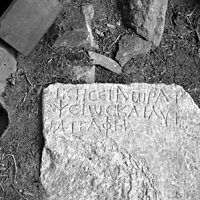 MAMA XI 232 (Kinna)
MAMA XI 232 (Kinna) 
Funerary stele with curse formula
- Type of monument:
- Funerary stele.
- Location:
- Yalınayak (Karacadağ) (Kinna): in a wall; said to have been brought from ruins one and a half hours to the south.
- Description:
- Coarse whitish marble stele, later reused as the base of a Byzantine double half-column. Cut away above and left; face rough-picked at right.
- Dimensions:
- Ht. 0.71+; W. 0.47+; Th. --; letters 0.030-0.040.
- Record:
- MB notebook copy; photograph (1957/27=5738).
- Publication:
- None.
- Date:
- Roman imperial period.
- - - - - - - - - - - - - -
[ὃς δὲ ταύτην στήλην]
[ἀδ]ικήσει, ἄωρα τ̣[έκ]-
[να θ]ά̣ψει, ὡς καὶ αὐτ[ὸς]
[(?) κεῖ]μ̣αι ταφῇ.
[...whoever wr]ongs [this stele], may he bury his children before their time, just as I too [lie?] in the tomb.




I have restored the beginning of the curse-formula on the basis of four other funerary inscriptions from this region: RECAM II 294 (Canımana), ὃς δὲ ταύτην [σ]τήλην ἀδικήση, κτλ.; RECAM II 302 (Canımana), ὃς ταύτην στήλην ἀδικήση, κτλ.; RECAM II 306 (Karacaören), ὃς δὲ ταύτην στήλην ἀδικήσα̣ι, κτλ.; RECAM II 309 (Yeşilköy), ἄν τις ἀδικήσει, ὀρφανὰ τέκνα λύποιτο κτλ. I can offer no close parallels for the remainder of the curse-formula. For the malediction expressing the hope that the violator’s children will die ἄωροι, see Robert, OMS V, 715-20. If my restoration in the final line is correct, the final clause would express the wish that the violator’s children suffer the same fate as the deceased: for comparable formulae, cf. TAM V 1, 626 (Daldis), εἰ δέ τις ταύτην τὴν στήλλην ἄρῃ... τὸν αὐτὸν μόρον πάθοιτο; BE 1939, 464 (Korykos), εἴ τις δὲ θέλῃ σώματ᾿ ἆραι τῆς ταφῆς, τὰ αὐτὰ πάθοιτον, ἃ ἐκῆ⟨ν⟩ι ἐν τοῖς σεισμοῖς; Merkelbach and Stauber 2001: 16/55/03 (Philomelion): ὅστις ἐμεῦ στήλλαν βαλέει λίθον οὐκ ἀδικηθείς, οὗτος τὰν αὐτὰν μοῖραν ἐμοὶ λαχέτω. For the phraseology ὡς καὶ αὐτ[ὸς] (line 2), cf. I.Parion 29, ὁ κακώσας τὴν εἰκόνα... πάθυ ἃ καὶ αὐτή. See further Robert, Hellenica II, 121 n.5; OMS V, 718 n.117.
For the re-use of inscriptions as Byzantine double half-columns, see the commentary to MAMA XI 150 (1955/45: Başkuyucak, Pentapolis).